Consultancy Report: Designer Systems Limited
VerifiedAdded on 2023/06/11
|15
|3111
|97
AI Summary
This report analyzes the effectiveness of Designer Systems Limited's leadership team by identifying its management and organizational leadership competency gaps. It offers recommendations on how to close the gaps and serves as a guide to gauge current management and leadership practices in the company.
Contribute Materials
Your contribution can guide someone’s learning journey. Share your
documents today.
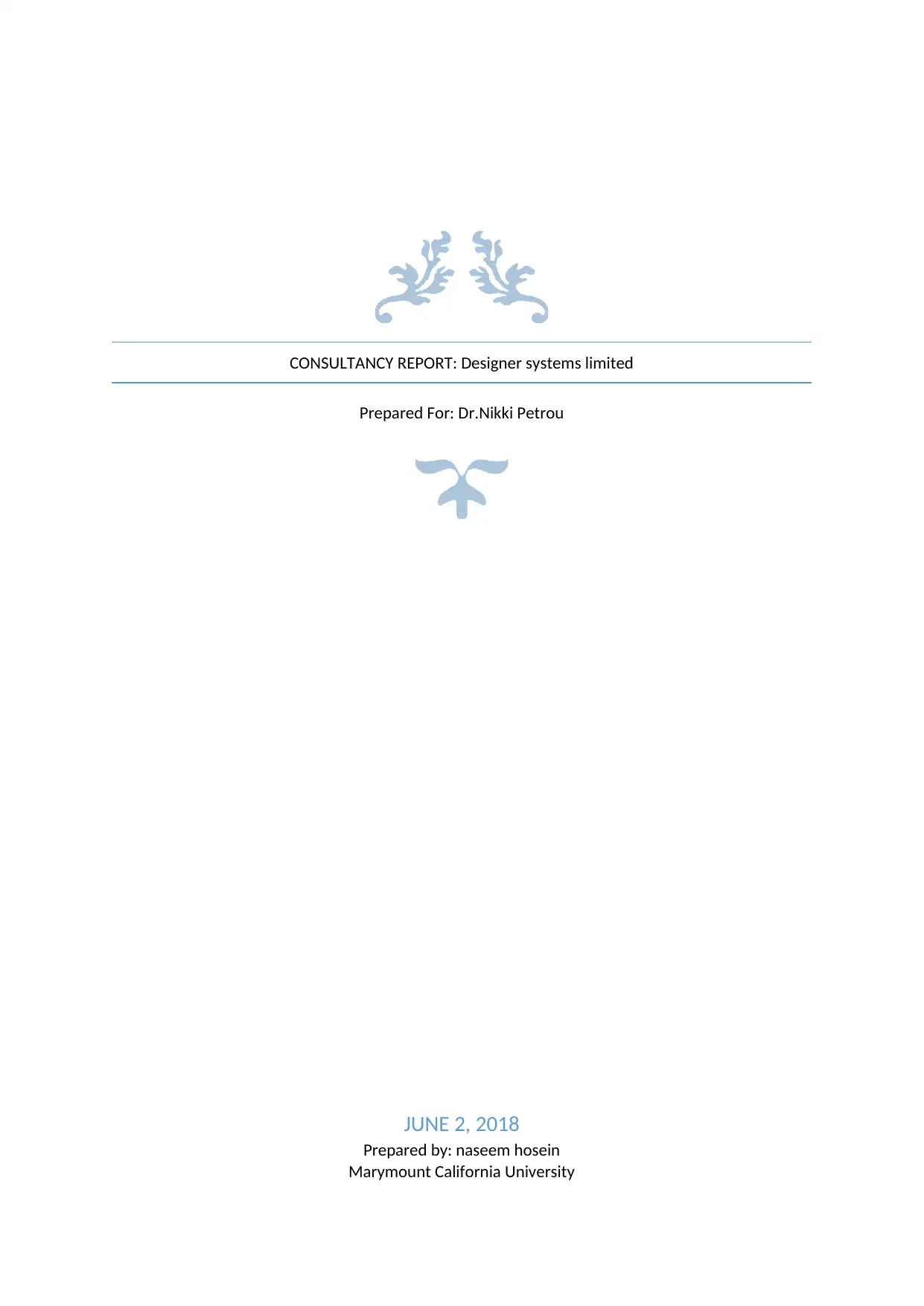
CONSULTANCY REPORT: Designer systems limited
Prepared For: Dr.Nikki Petrou
JUNE 2, 2018
Prepared by: naseem hosein
Marymount California University
Prepared For: Dr.Nikki Petrou
JUNE 2, 2018
Prepared by: naseem hosein
Marymount California University
Secure Best Marks with AI Grader
Need help grading? Try our AI Grader for instant feedback on your assignments.
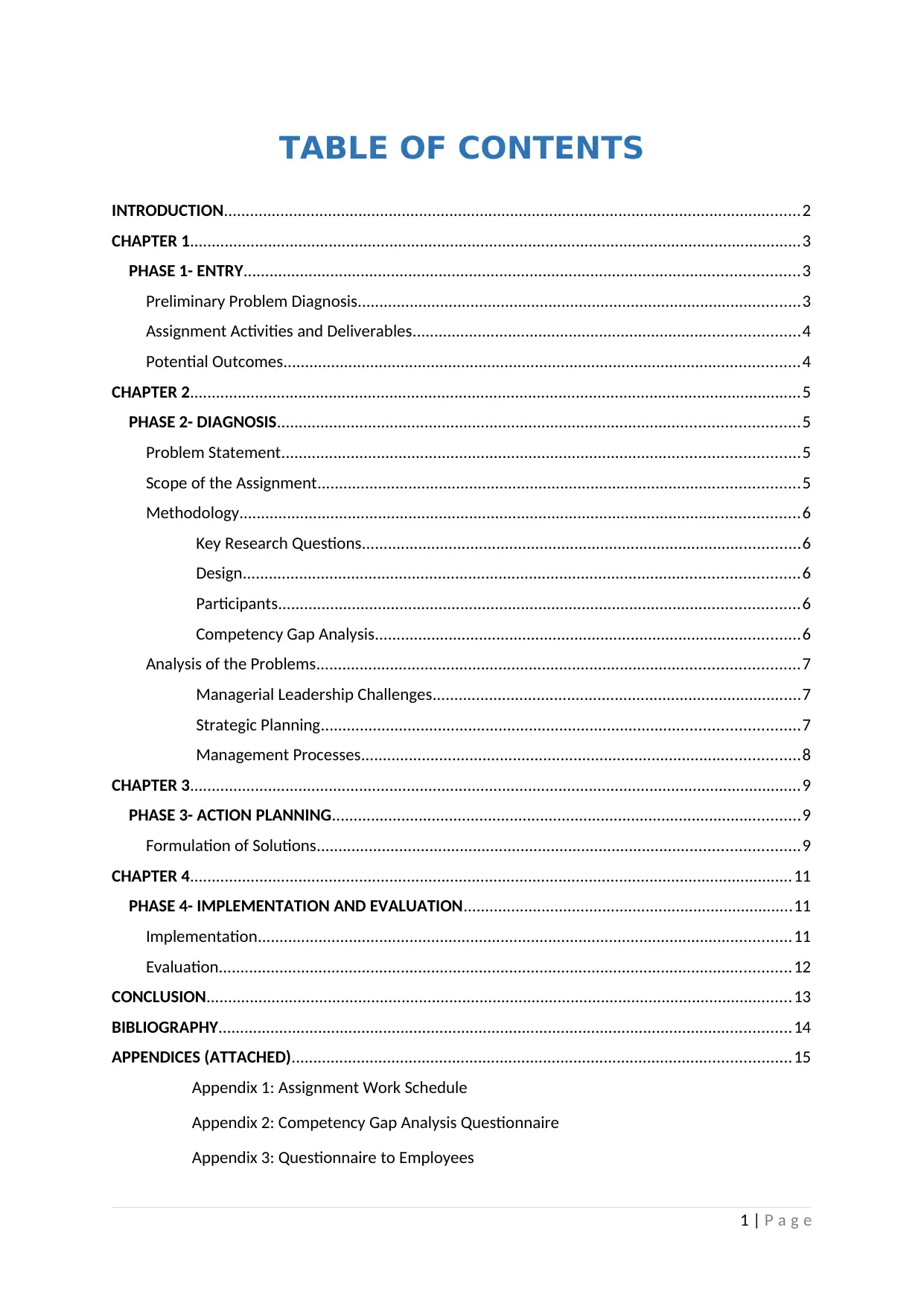
TABLE OF CONTENTS
INTRODUCTION.....................................................................................................................................2
CHAPTER 1.............................................................................................................................................3
PHASE 1- ENTRY................................................................................................................................3
Preliminary Problem Diagnosis......................................................................................................3
Assignment Activities and Deliverables.........................................................................................4
Potential Outcomes.......................................................................................................................4
CHAPTER 2.............................................................................................................................................5
PHASE 2- DIAGNOSIS........................................................................................................................5
Problem Statement.......................................................................................................................5
Scope of the Assignment...............................................................................................................5
Methodology.................................................................................................................................6
Key Research Questions.....................................................................................................6
Design................................................................................................................................6
Participants........................................................................................................................6
Competency Gap Analysis..................................................................................................6
Analysis of the Problems...............................................................................................................7
Managerial Leadership Challenges.....................................................................................7
Strategic Planning..............................................................................................................7
Management Processes.....................................................................................................8
CHAPTER 3.............................................................................................................................................9
PHASE 3- ACTION PLANNING............................................................................................................9
Formulation of Solutions...............................................................................................................9
CHAPTER 4...........................................................................................................................................11
PHASE 4- IMPLEMENTATION AND EVALUATION............................................................................11
Implementation...........................................................................................................................11
Evaluation....................................................................................................................................12
CONCLUSION.......................................................................................................................................13
BIBLIOGRAPHY....................................................................................................................................14
APPENDICES (ATTACHED)...................................................................................................................15
Appendix 1: Assignment Work Schedule
Appendix 2: Competency Gap Analysis Questionnaire
Appendix 3: Questionnaire to Employees
1 | P a g e
INTRODUCTION.....................................................................................................................................2
CHAPTER 1.............................................................................................................................................3
PHASE 1- ENTRY................................................................................................................................3
Preliminary Problem Diagnosis......................................................................................................3
Assignment Activities and Deliverables.........................................................................................4
Potential Outcomes.......................................................................................................................4
CHAPTER 2.............................................................................................................................................5
PHASE 2- DIAGNOSIS........................................................................................................................5
Problem Statement.......................................................................................................................5
Scope of the Assignment...............................................................................................................5
Methodology.................................................................................................................................6
Key Research Questions.....................................................................................................6
Design................................................................................................................................6
Participants........................................................................................................................6
Competency Gap Analysis..................................................................................................6
Analysis of the Problems...............................................................................................................7
Managerial Leadership Challenges.....................................................................................7
Strategic Planning..............................................................................................................7
Management Processes.....................................................................................................8
CHAPTER 3.............................................................................................................................................9
PHASE 3- ACTION PLANNING............................................................................................................9
Formulation of Solutions...............................................................................................................9
CHAPTER 4...........................................................................................................................................11
PHASE 4- IMPLEMENTATION AND EVALUATION............................................................................11
Implementation...........................................................................................................................11
Evaluation....................................................................................................................................12
CONCLUSION.......................................................................................................................................13
BIBLIOGRAPHY....................................................................................................................................14
APPENDICES (ATTACHED)...................................................................................................................15
Appendix 1: Assignment Work Schedule
Appendix 2: Competency Gap Analysis Questionnaire
Appendix 3: Questionnaire to Employees
1 | P a g e
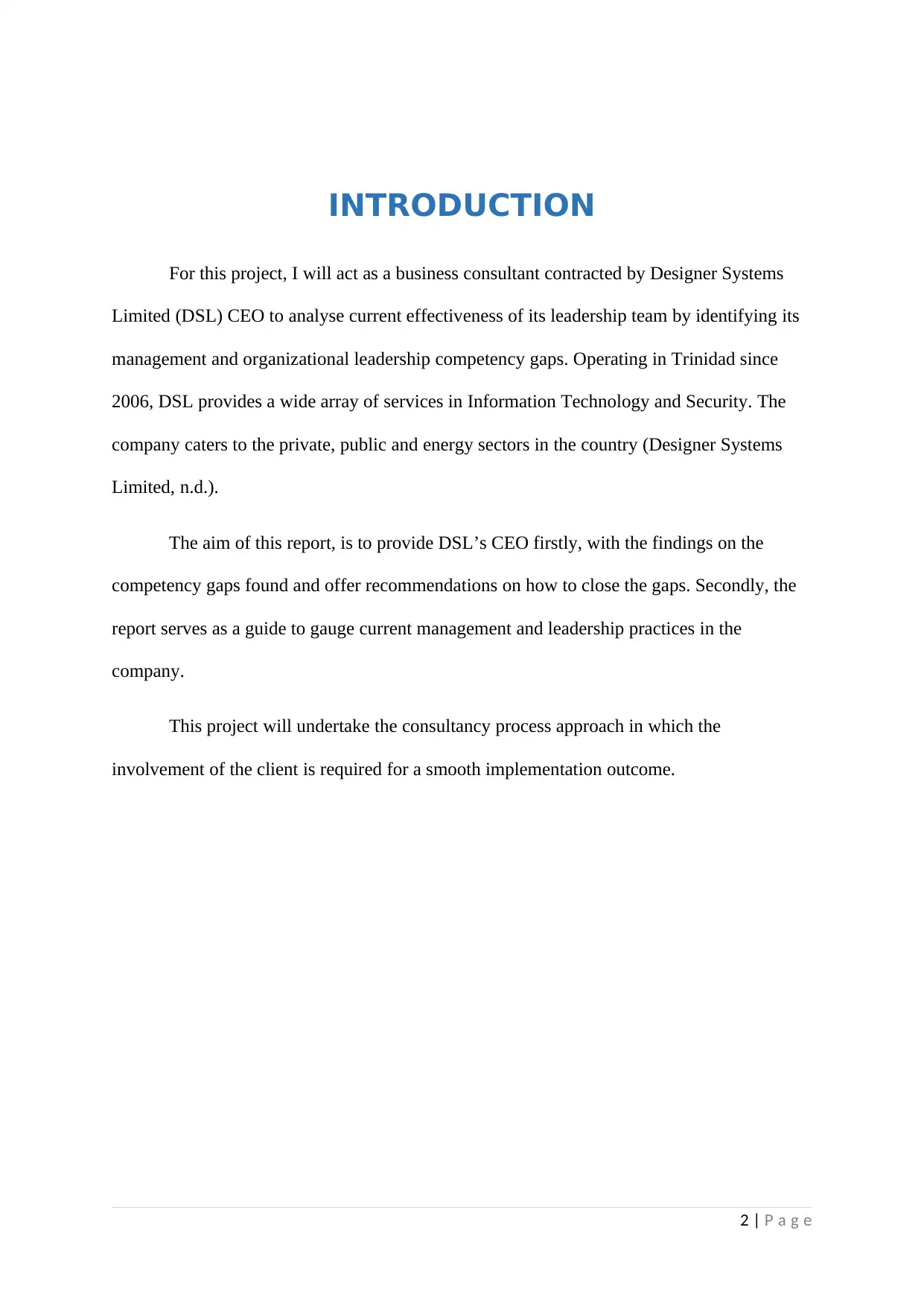
INTRODUCTION
For this project, I will act as a business consultant contracted by Designer Systems
Limited (DSL) CEO to analyse current effectiveness of its leadership team by identifying its
management and organizational leadership competency gaps. Operating in Trinidad since
2006, DSL provides a wide array of services in Information Technology and Security. The
company caters to the private, public and energy sectors in the country (Designer Systems
Limited, n.d.).
The aim of this report, is to provide DSL’s CEO firstly, with the findings on the
competency gaps found and offer recommendations on how to close the gaps. Secondly, the
report serves as a guide to gauge current management and leadership practices in the
company.
This project will undertake the consultancy process approach in which the
involvement of the client is required for a smooth implementation outcome.
2 | P a g e
For this project, I will act as a business consultant contracted by Designer Systems
Limited (DSL) CEO to analyse current effectiveness of its leadership team by identifying its
management and organizational leadership competency gaps. Operating in Trinidad since
2006, DSL provides a wide array of services in Information Technology and Security. The
company caters to the private, public and energy sectors in the country (Designer Systems
Limited, n.d.).
The aim of this report, is to provide DSL’s CEO firstly, with the findings on the
competency gaps found and offer recommendations on how to close the gaps. Secondly, the
report serves as a guide to gauge current management and leadership practices in the
company.
This project will undertake the consultancy process approach in which the
involvement of the client is required for a smooth implementation outcome.
2 | P a g e
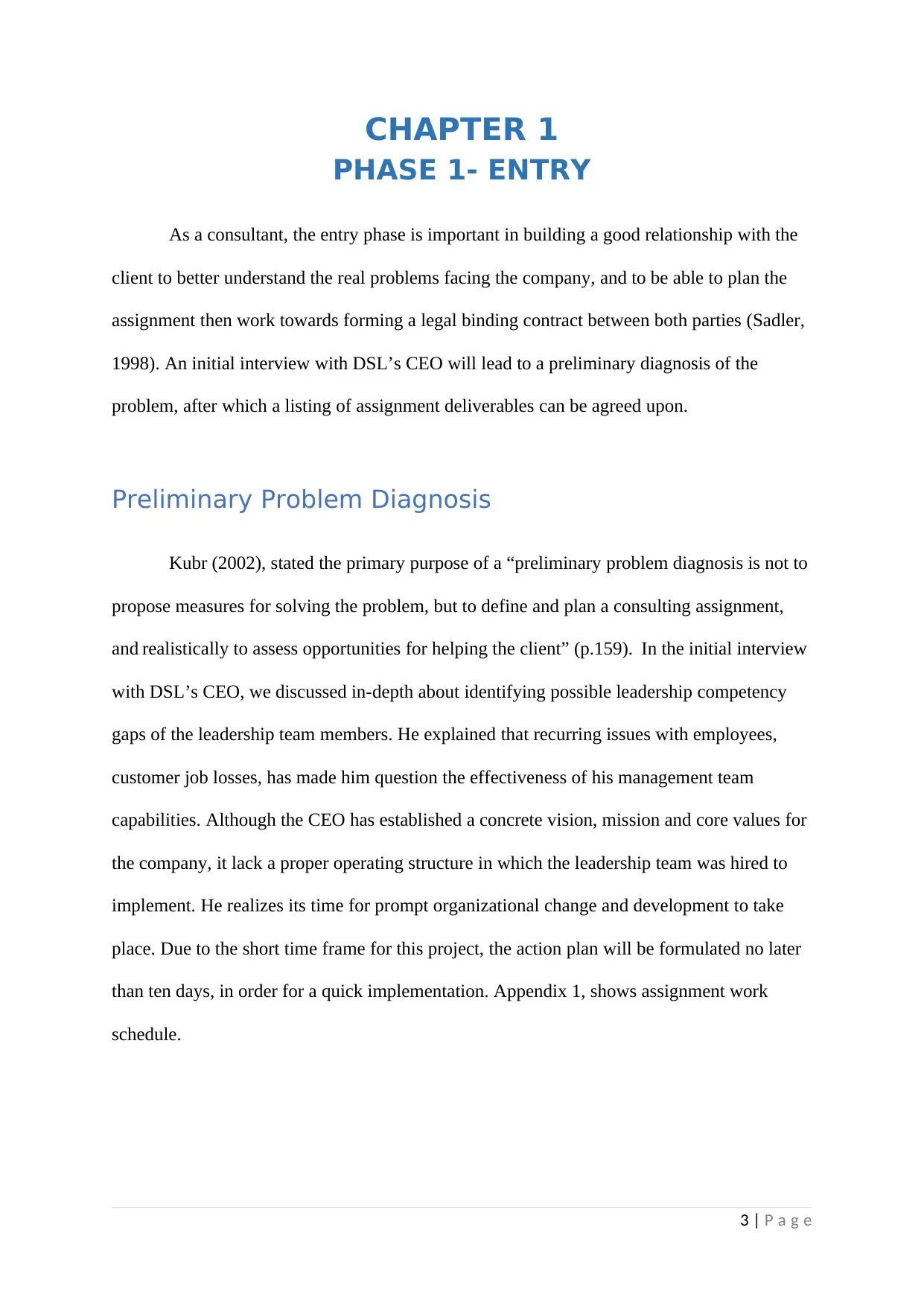
CHAPTER 1
PHASE 1- ENTRY
As a consultant, the entry phase is important in building a good relationship with the
client to better understand the real problems facing the company, and to be able to plan the
assignment then work towards forming a legal binding contract between both parties (Sadler,
1998). An initial interview with DSL’s CEO will lead to a preliminary diagnosis of the
problem, after which a listing of assignment deliverables can be agreed upon.
Preliminary Problem Diagnosis
Kubr (2002), stated the primary purpose of a “preliminary problem diagnosis is not to
propose measures for solving the problem, but to define and plan a consulting assignment,
and realistically to assess opportunities for helping the client” (p.159). In the initial interview
with DSL’s CEO, we discussed in-depth about identifying possible leadership competency
gaps of the leadership team members. He explained that recurring issues with employees,
customer job losses, has made him question the effectiveness of his management team
capabilities. Although the CEO has established a concrete vision, mission and core values for
the company, it lack a proper operating structure in which the leadership team was hired to
implement. He realizes its time for prompt organizational change and development to take
place. Due to the short time frame for this project, the action plan will be formulated no later
than ten days, in order for a quick implementation. Appendix 1, shows assignment work
schedule.
3 | P a g e
PHASE 1- ENTRY
As a consultant, the entry phase is important in building a good relationship with the
client to better understand the real problems facing the company, and to be able to plan the
assignment then work towards forming a legal binding contract between both parties (Sadler,
1998). An initial interview with DSL’s CEO will lead to a preliminary diagnosis of the
problem, after which a listing of assignment deliverables can be agreed upon.
Preliminary Problem Diagnosis
Kubr (2002), stated the primary purpose of a “preliminary problem diagnosis is not to
propose measures for solving the problem, but to define and plan a consulting assignment,
and realistically to assess opportunities for helping the client” (p.159). In the initial interview
with DSL’s CEO, we discussed in-depth about identifying possible leadership competency
gaps of the leadership team members. He explained that recurring issues with employees,
customer job losses, has made him question the effectiveness of his management team
capabilities. Although the CEO has established a concrete vision, mission and core values for
the company, it lack a proper operating structure in which the leadership team was hired to
implement. He realizes its time for prompt organizational change and development to take
place. Due to the short time frame for this project, the action plan will be formulated no later
than ten days, in order for a quick implementation. Appendix 1, shows assignment work
schedule.
3 | P a g e
Secure Best Marks with AI Grader
Need help grading? Try our AI Grader for instant feedback on your assignments.
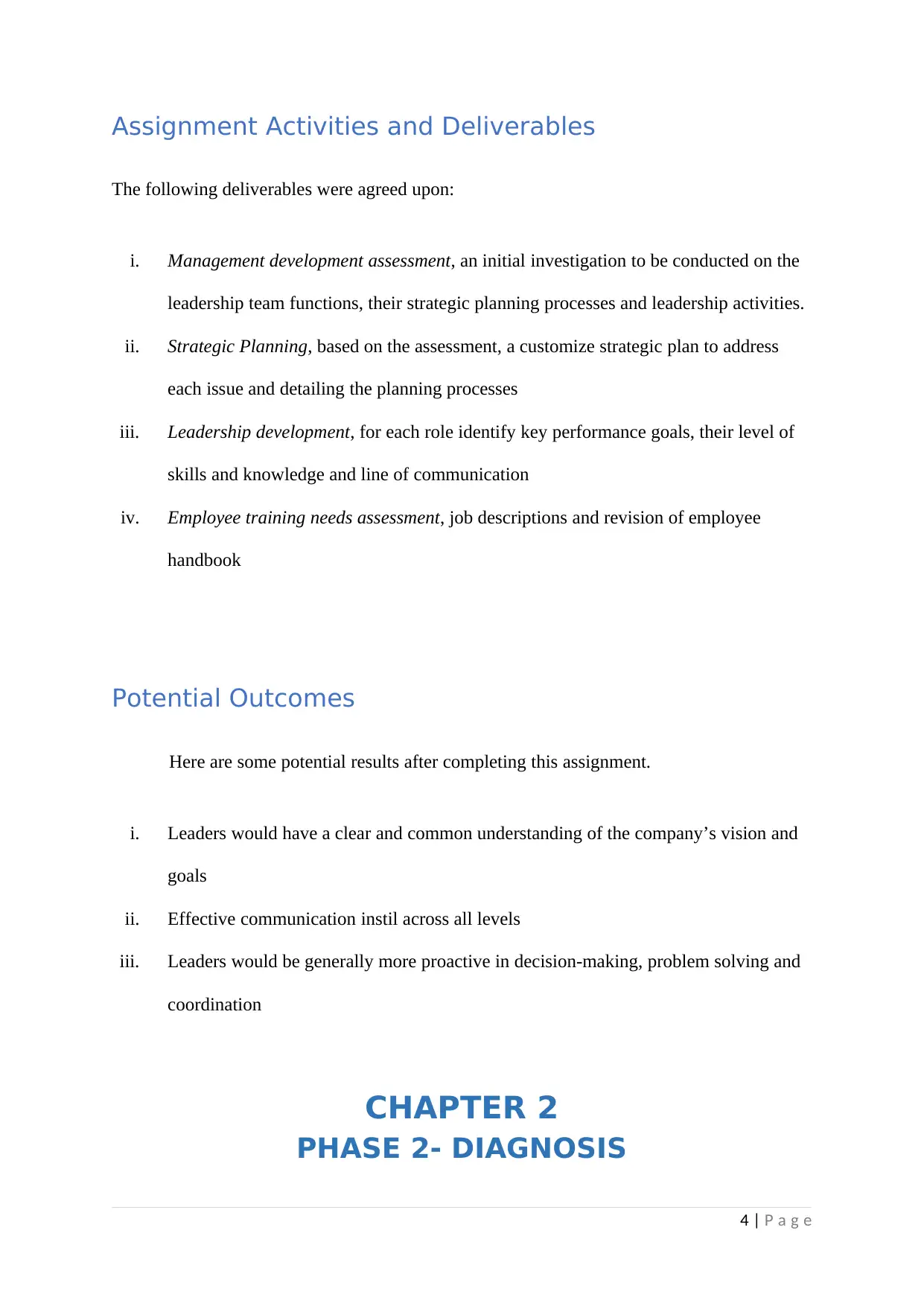
Assignment Activities and Deliverables
The following deliverables were agreed upon:
i. Management development assessment, an initial investigation to be conducted on the
leadership team functions, their strategic planning processes and leadership activities.
ii. Strategic Planning, based on the assessment, a customize strategic plan to address
each issue and detailing the planning processes
iii. Leadership development, for each role identify key performance goals, their level of
skills and knowledge and line of communication
iv. Employee training needs assessment, job descriptions and revision of employee
handbook
Potential Outcomes
Here are some potential results after completing this assignment.
i. Leaders would have a clear and common understanding of the company’s vision and
goals
ii. Effective communication instil across all levels
iii. Leaders would be generally more proactive in decision-making, problem solving and
coordination
CHAPTER 2
PHASE 2- DIAGNOSIS
4 | P a g e
The following deliverables were agreed upon:
i. Management development assessment, an initial investigation to be conducted on the
leadership team functions, their strategic planning processes and leadership activities.
ii. Strategic Planning, based on the assessment, a customize strategic plan to address
each issue and detailing the planning processes
iii. Leadership development, for each role identify key performance goals, their level of
skills and knowledge and line of communication
iv. Employee training needs assessment, job descriptions and revision of employee
handbook
Potential Outcomes
Here are some potential results after completing this assignment.
i. Leaders would have a clear and common understanding of the company’s vision and
goals
ii. Effective communication instil across all levels
iii. Leaders would be generally more proactive in decision-making, problem solving and
coordination
CHAPTER 2
PHASE 2- DIAGNOSIS
4 | P a g e
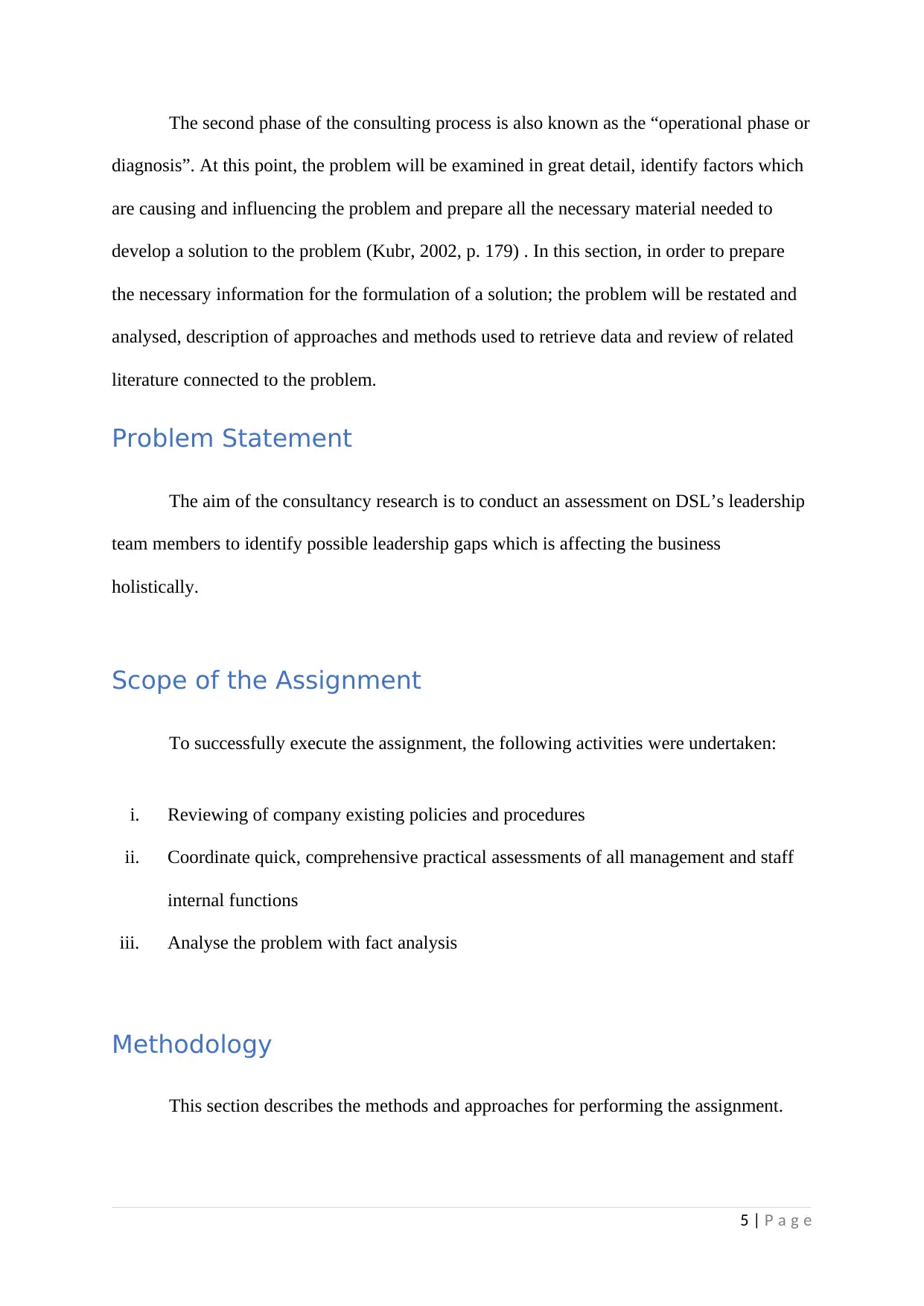
The second phase of the consulting process is also known as the “operational phase or
diagnosis”. At this point, the problem will be examined in great detail, identify factors which
are causing and influencing the problem and prepare all the necessary material needed to
develop a solution to the problem (Kubr, 2002, p. 179) . In this section, in order to prepare
the necessary information for the formulation of a solution; the problem will be restated and
analysed, description of approaches and methods used to retrieve data and review of related
literature connected to the problem.
Problem Statement
The aim of the consultancy research is to conduct an assessment on DSL’s leadership
team members to identify possible leadership gaps which is affecting the business
holistically.
Scope of the Assignment
To successfully execute the assignment, the following activities were undertaken:
i. Reviewing of company existing policies and procedures
ii. Coordinate quick, comprehensive practical assessments of all management and staff
internal functions
iii. Analyse the problem with fact analysis
Methodology
This section describes the methods and approaches for performing the assignment.
5 | P a g e
diagnosis”. At this point, the problem will be examined in great detail, identify factors which
are causing and influencing the problem and prepare all the necessary material needed to
develop a solution to the problem (Kubr, 2002, p. 179) . In this section, in order to prepare
the necessary information for the formulation of a solution; the problem will be restated and
analysed, description of approaches and methods used to retrieve data and review of related
literature connected to the problem.
Problem Statement
The aim of the consultancy research is to conduct an assessment on DSL’s leadership
team members to identify possible leadership gaps which is affecting the business
holistically.
Scope of the Assignment
To successfully execute the assignment, the following activities were undertaken:
i. Reviewing of company existing policies and procedures
ii. Coordinate quick, comprehensive practical assessments of all management and staff
internal functions
iii. Analyse the problem with fact analysis
Methodology
This section describes the methods and approaches for performing the assignment.
5 | P a g e
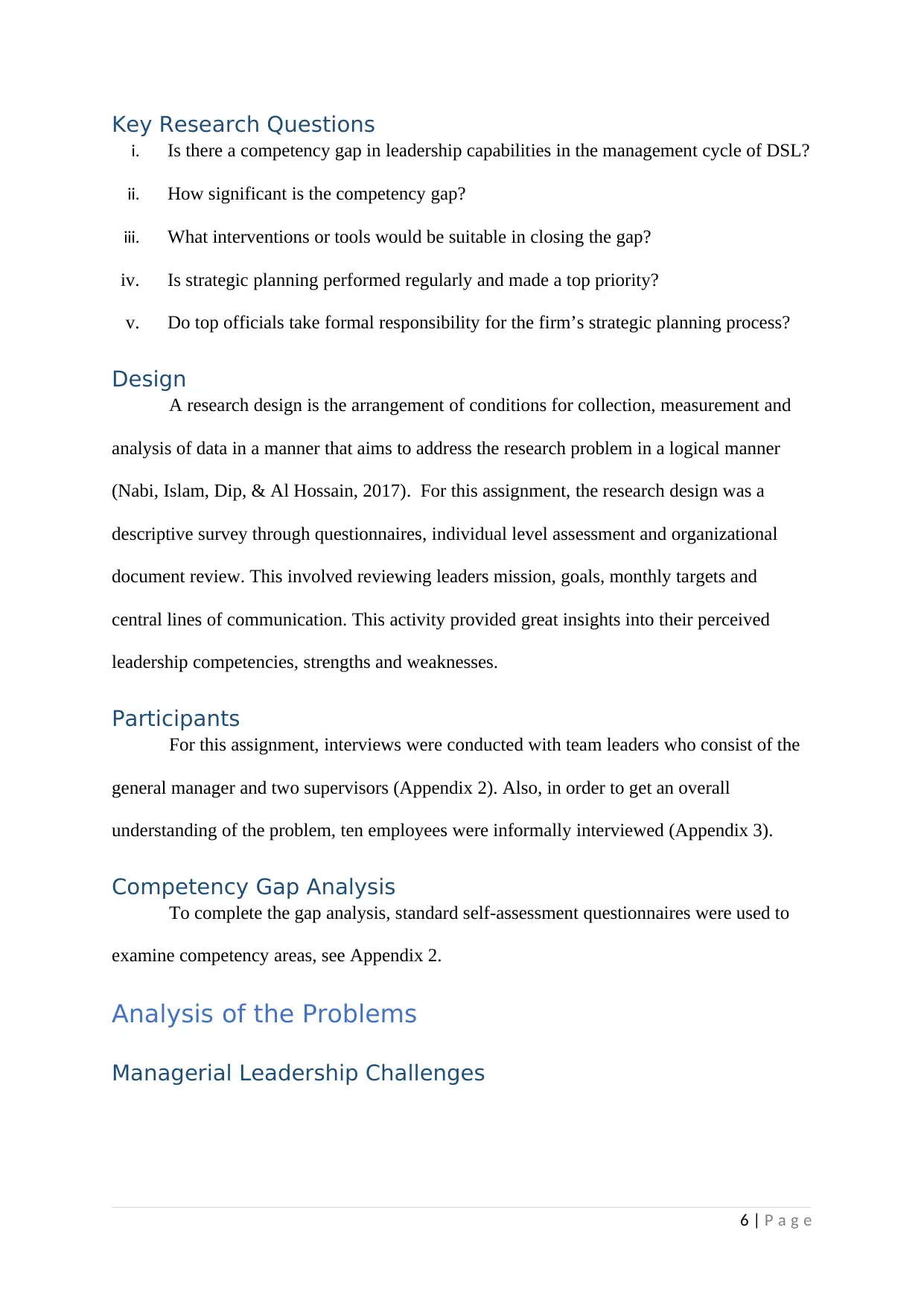
Key Research Questions
i. Is there a competency gap in leadership capabilities in the management cycle of DSL?
ii. How significant is the competency gap?
iii. What interventions or tools would be suitable in closing the gap?
iv. Is strategic planning performed regularly and made a top priority?
v. Do top officials take formal responsibility for the firm’s strategic planning process?
Design
A research design is the arrangement of conditions for collection, measurement and
analysis of data in a manner that aims to address the research problem in a logical manner
(Nabi, Islam, Dip, & Al Hossain, 2017). For this assignment, the research design was a
descriptive survey through questionnaires, individual level assessment and organizational
document review. This involved reviewing leaders mission, goals, monthly targets and
central lines of communication. This activity provided great insights into their perceived
leadership competencies, strengths and weaknesses.
Participants
For this assignment, interviews were conducted with team leaders who consist of the
general manager and two supervisors (Appendix 2). Also, in order to get an overall
understanding of the problem, ten employees were informally interviewed (Appendix 3).
Competency Gap Analysis
To complete the gap analysis, standard self-assessment questionnaires were used to
examine competency areas, see Appendix 2.
Analysis of the Problems
Managerial Leadership Challenges
6 | P a g e
i. Is there a competency gap in leadership capabilities in the management cycle of DSL?
ii. How significant is the competency gap?
iii. What interventions or tools would be suitable in closing the gap?
iv. Is strategic planning performed regularly and made a top priority?
v. Do top officials take formal responsibility for the firm’s strategic planning process?
Design
A research design is the arrangement of conditions for collection, measurement and
analysis of data in a manner that aims to address the research problem in a logical manner
(Nabi, Islam, Dip, & Al Hossain, 2017). For this assignment, the research design was a
descriptive survey through questionnaires, individual level assessment and organizational
document review. This involved reviewing leaders mission, goals, monthly targets and
central lines of communication. This activity provided great insights into their perceived
leadership competencies, strengths and weaknesses.
Participants
For this assignment, interviews were conducted with team leaders who consist of the
general manager and two supervisors (Appendix 2). Also, in order to get an overall
understanding of the problem, ten employees were informally interviewed (Appendix 3).
Competency Gap Analysis
To complete the gap analysis, standard self-assessment questionnaires were used to
examine competency areas, see Appendix 2.
Analysis of the Problems
Managerial Leadership Challenges
6 | P a g e
Paraphrase This Document
Need a fresh take? Get an instant paraphrase of this document with our AI Paraphraser
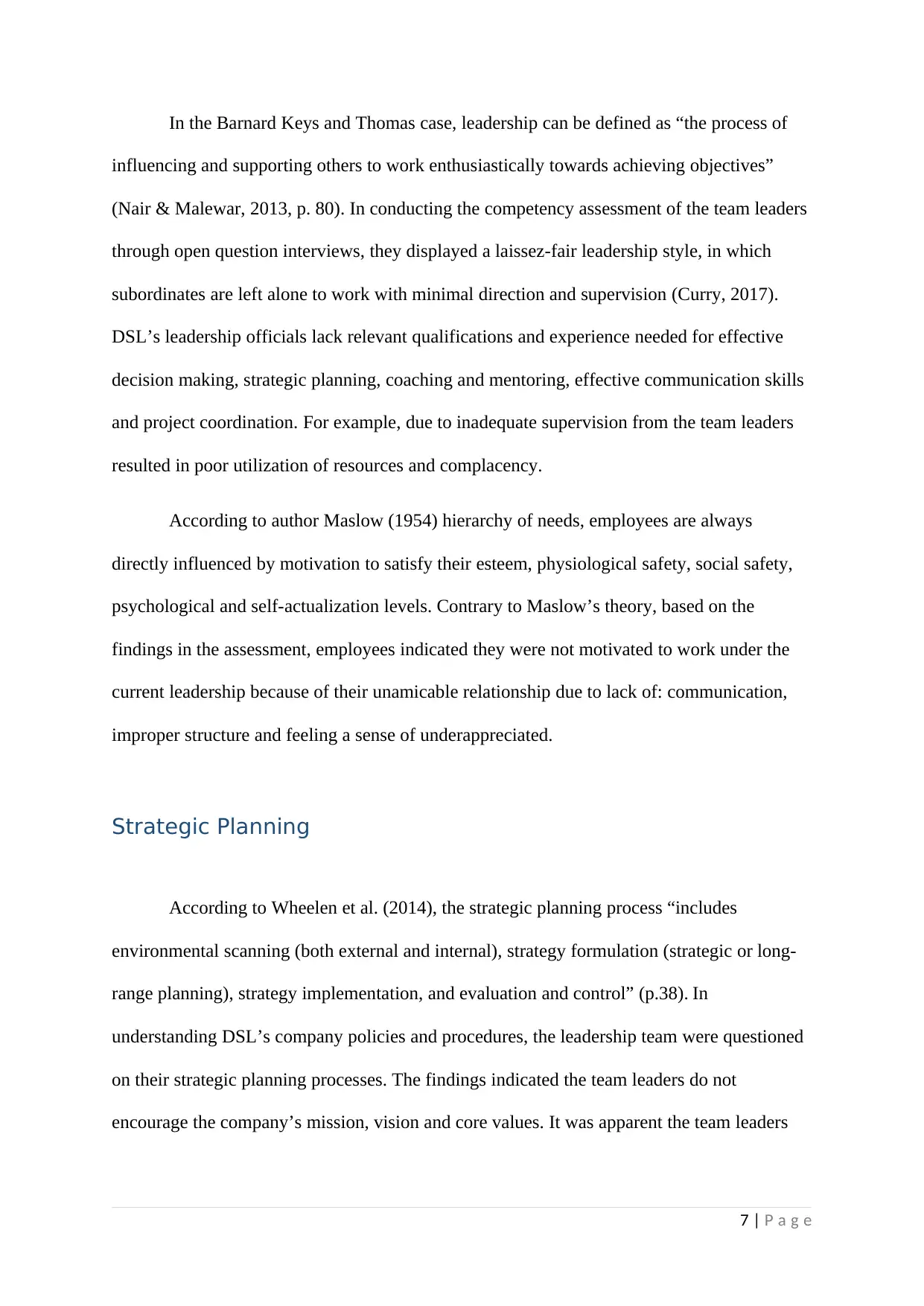
In the Barnard Keys and Thomas case, leadership can be defined as “the process of
influencing and supporting others to work enthusiastically towards achieving objectives”
(Nair & Malewar, 2013, p. 80). In conducting the competency assessment of the team leaders
through open question interviews, they displayed a laissez-fair leadership style, in which
subordinates are left alone to work with minimal direction and supervision (Curry, 2017).
DSL’s leadership officials lack relevant qualifications and experience needed for effective
decision making, strategic planning, coaching and mentoring, effective communication skills
and project coordination. For example, due to inadequate supervision from the team leaders
resulted in poor utilization of resources and complacency.
According to author Maslow (1954) hierarchy of needs, employees are always
directly influenced by motivation to satisfy their esteem, physiological safety, social safety,
psychological and self-actualization levels. Contrary to Maslow’s theory, based on the
findings in the assessment, employees indicated they were not motivated to work under the
current leadership because of their unamicable relationship due to lack of: communication,
improper structure and feeling a sense of underappreciated.
Strategic Planning
According to Wheelen et al. (2014), the strategic planning process “includes
environmental scanning (both external and internal), strategy formulation (strategic or long-
range planning), strategy implementation, and evaluation and control” (p.38). In
understanding DSL’s company policies and procedures, the leadership team were questioned
on their strategic planning processes. The findings indicated the team leaders do not
encourage the company’s mission, vision and core values. It was apparent the team leaders
7 | P a g e
influencing and supporting others to work enthusiastically towards achieving objectives”
(Nair & Malewar, 2013, p. 80). In conducting the competency assessment of the team leaders
through open question interviews, they displayed a laissez-fair leadership style, in which
subordinates are left alone to work with minimal direction and supervision (Curry, 2017).
DSL’s leadership officials lack relevant qualifications and experience needed for effective
decision making, strategic planning, coaching and mentoring, effective communication skills
and project coordination. For example, due to inadequate supervision from the team leaders
resulted in poor utilization of resources and complacency.
According to author Maslow (1954) hierarchy of needs, employees are always
directly influenced by motivation to satisfy their esteem, physiological safety, social safety,
psychological and self-actualization levels. Contrary to Maslow’s theory, based on the
findings in the assessment, employees indicated they were not motivated to work under the
current leadership because of their unamicable relationship due to lack of: communication,
improper structure and feeling a sense of underappreciated.
Strategic Planning
According to Wheelen et al. (2014), the strategic planning process “includes
environmental scanning (both external and internal), strategy formulation (strategic or long-
range planning), strategy implementation, and evaluation and control” (p.38). In
understanding DSL’s company policies and procedures, the leadership team were questioned
on their strategic planning processes. The findings indicated the team leaders do not
encourage the company’s mission, vision and core values. It was apparent the team leaders
7 | P a g e
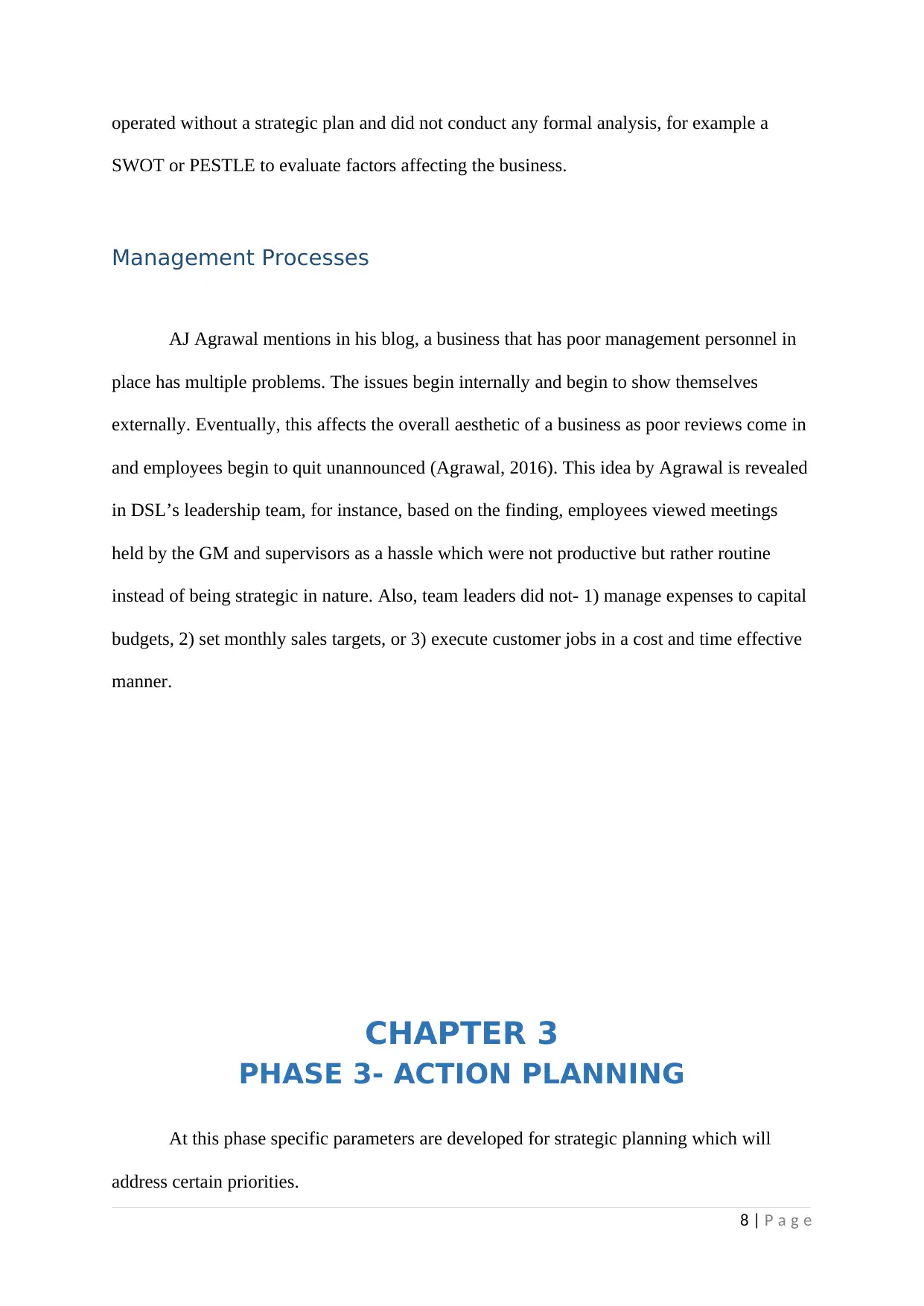
operated without a strategic plan and did not conduct any formal analysis, for example a
SWOT or PESTLE to evaluate factors affecting the business.
Management Processes
AJ Agrawal mentions in his blog, a business that has poor management personnel in
place has multiple problems. The issues begin internally and begin to show themselves
externally. Eventually, this affects the overall aesthetic of a business as poor reviews come in
and employees begin to quit unannounced (Agrawal, 2016). This idea by Agrawal is revealed
in DSL’s leadership team, for instance, based on the finding, employees viewed meetings
held by the GM and supervisors as a hassle which were not productive but rather routine
instead of being strategic in nature. Also, team leaders did not- 1) manage expenses to capital
budgets, 2) set monthly sales targets, or 3) execute customer jobs in a cost and time effective
manner.
CHAPTER 3
PHASE 3- ACTION PLANNING
At this phase specific parameters are developed for strategic planning which will
address certain priorities.
8 | P a g e
SWOT or PESTLE to evaluate factors affecting the business.
Management Processes
AJ Agrawal mentions in his blog, a business that has poor management personnel in
place has multiple problems. The issues begin internally and begin to show themselves
externally. Eventually, this affects the overall aesthetic of a business as poor reviews come in
and employees begin to quit unannounced (Agrawal, 2016). This idea by Agrawal is revealed
in DSL’s leadership team, for instance, based on the finding, employees viewed meetings
held by the GM and supervisors as a hassle which were not productive but rather routine
instead of being strategic in nature. Also, team leaders did not- 1) manage expenses to capital
budgets, 2) set monthly sales targets, or 3) execute customer jobs in a cost and time effective
manner.
CHAPTER 3
PHASE 3- ACTION PLANNING
At this phase specific parameters are developed for strategic planning which will
address certain priorities.
8 | P a g e
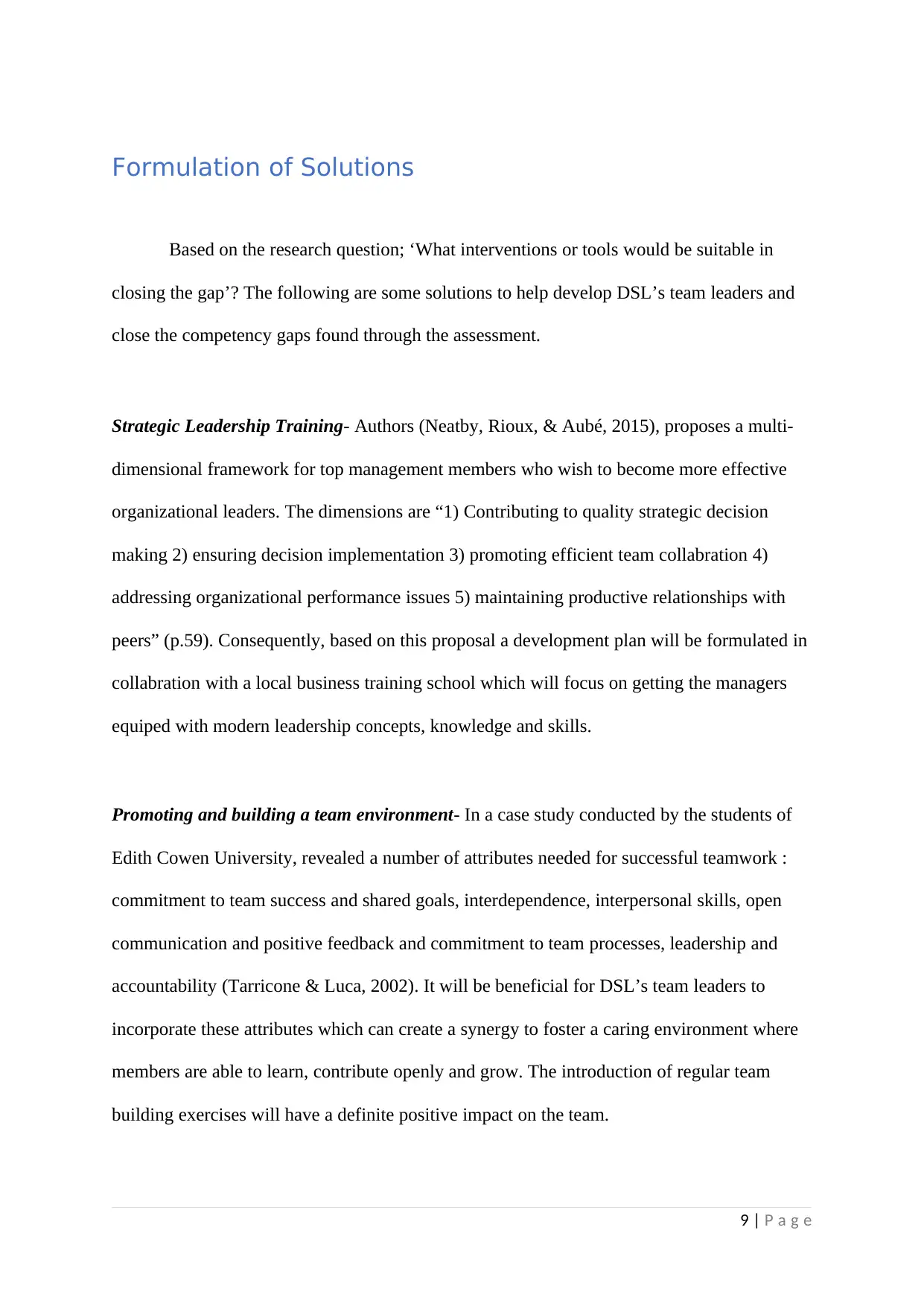
Formulation of Solutions
Based on the research question; ‘What interventions or tools would be suitable in
closing the gap’? The following are some solutions to help develop DSL’s team leaders and
close the competency gaps found through the assessment.
Strategic Leadership Training- Authors (Neatby, Rioux, & Aubé, 2015), proposes a multi-
dimensional framework for top management members who wish to become more effective
organizational leaders. The dimensions are “1) Contributing to quality strategic decision
making 2) ensuring decision implementation 3) promoting efficient team collabration 4)
addressing organizational performance issues 5) maintaining productive relationships with
peers” (p.59). Consequently, based on this proposal a development plan will be formulated in
collabration with a local business training school which will focus on getting the managers
equiped with modern leadership concepts, knowledge and skills.
Promoting and building a team environment- In a case study conducted by the students of
Edith Cowen University, revealed a number of attributes needed for successful teamwork :
commitment to team success and shared goals, interdependence, interpersonal skills, open
communication and positive feedback and commitment to team processes, leadership and
accountability (Tarricone & Luca, 2002). It will be beneficial for DSL’s team leaders to
incorporate these attributes which can create a synergy to foster a caring environment where
members are able to learn, contribute openly and grow. The introduction of regular team
building exercises will have a definite positive impact on the team.
9 | P a g e
Based on the research question; ‘What interventions or tools would be suitable in
closing the gap’? The following are some solutions to help develop DSL’s team leaders and
close the competency gaps found through the assessment.
Strategic Leadership Training- Authors (Neatby, Rioux, & Aubé, 2015), proposes a multi-
dimensional framework for top management members who wish to become more effective
organizational leaders. The dimensions are “1) Contributing to quality strategic decision
making 2) ensuring decision implementation 3) promoting efficient team collabration 4)
addressing organizational performance issues 5) maintaining productive relationships with
peers” (p.59). Consequently, based on this proposal a development plan will be formulated in
collabration with a local business training school which will focus on getting the managers
equiped with modern leadership concepts, knowledge and skills.
Promoting and building a team environment- In a case study conducted by the students of
Edith Cowen University, revealed a number of attributes needed for successful teamwork :
commitment to team success and shared goals, interdependence, interpersonal skills, open
communication and positive feedback and commitment to team processes, leadership and
accountability (Tarricone & Luca, 2002). It will be beneficial for DSL’s team leaders to
incorporate these attributes which can create a synergy to foster a caring environment where
members are able to learn, contribute openly and grow. The introduction of regular team
building exercises will have a definite positive impact on the team.
9 | P a g e
Secure Best Marks with AI Grader
Need help grading? Try our AI Grader for instant feedback on your assignments.
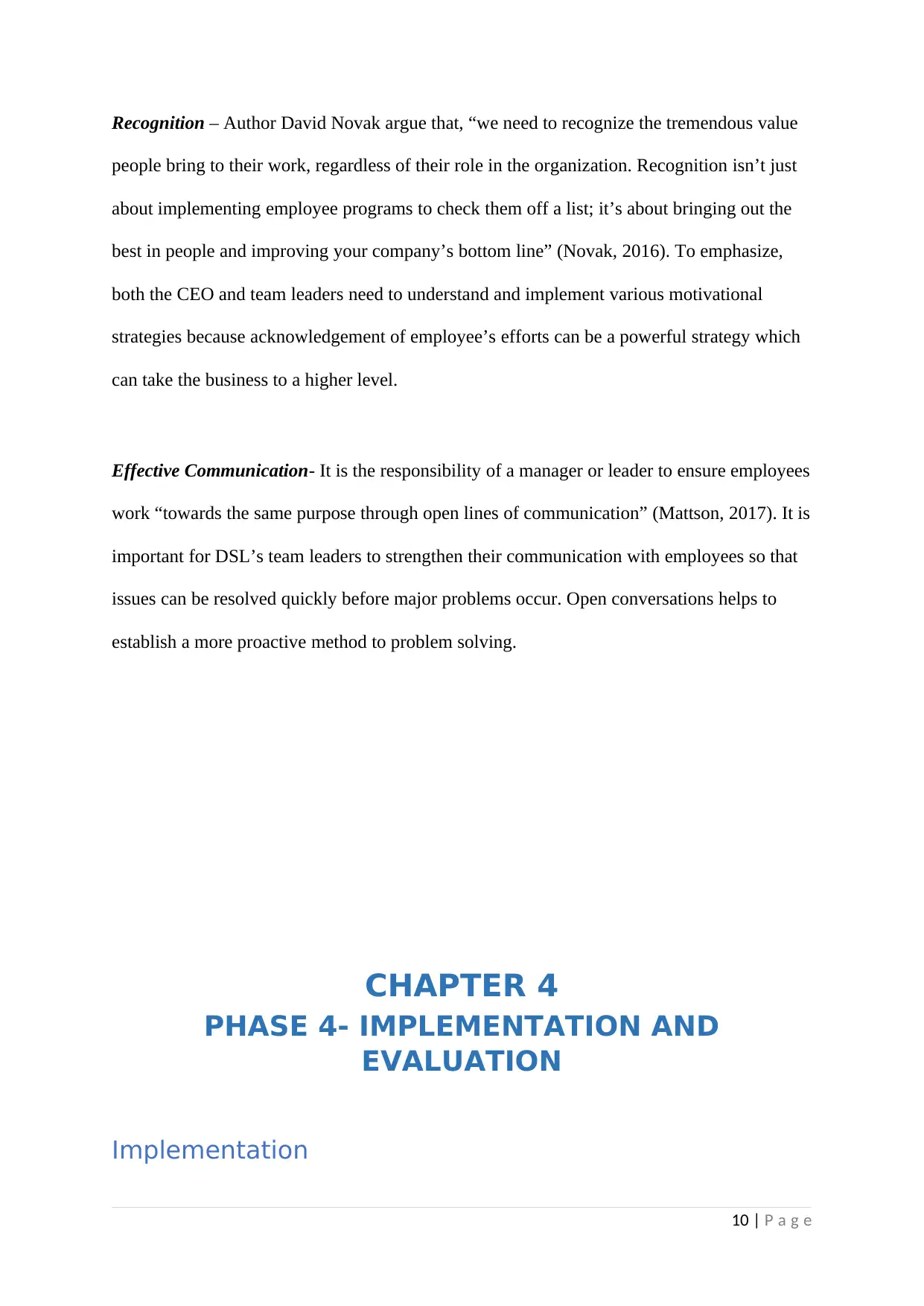
Recognition – Author David Novak argue that, “we need to recognize the tremendous value
people bring to their work, regardless of their role in the organization. Recognition isn’t just
about implementing employee programs to check them off a list; it’s about bringing out the
best in people and improving your company’s bottom line” (Novak, 2016). To emphasize,
both the CEO and team leaders need to understand and implement various motivational
strategies because acknowledgement of employee’s efforts can be a powerful strategy which
can take the business to a higher level.
Effective Communication- It is the responsibility of a manager or leader to ensure employees
work “towards the same purpose through open lines of communication” (Mattson, 2017). It is
important for DSL’s team leaders to strengthen their communication with employees so that
issues can be resolved quickly before major problems occur. Open conversations helps to
establish a more proactive method to problem solving.
CHAPTER 4
PHASE 4- IMPLEMENTATION AND
EVALUATION
Implementation
10 | P a g e
people bring to their work, regardless of their role in the organization. Recognition isn’t just
about implementing employee programs to check them off a list; it’s about bringing out the
best in people and improving your company’s bottom line” (Novak, 2016). To emphasize,
both the CEO and team leaders need to understand and implement various motivational
strategies because acknowledgement of employee’s efforts can be a powerful strategy which
can take the business to a higher level.
Effective Communication- It is the responsibility of a manager or leader to ensure employees
work “towards the same purpose through open lines of communication” (Mattson, 2017). It is
important for DSL’s team leaders to strengthen their communication with employees so that
issues can be resolved quickly before major problems occur. Open conversations helps to
establish a more proactive method to problem solving.
CHAPTER 4
PHASE 4- IMPLEMENTATION AND
EVALUATION
Implementation
10 | P a g e
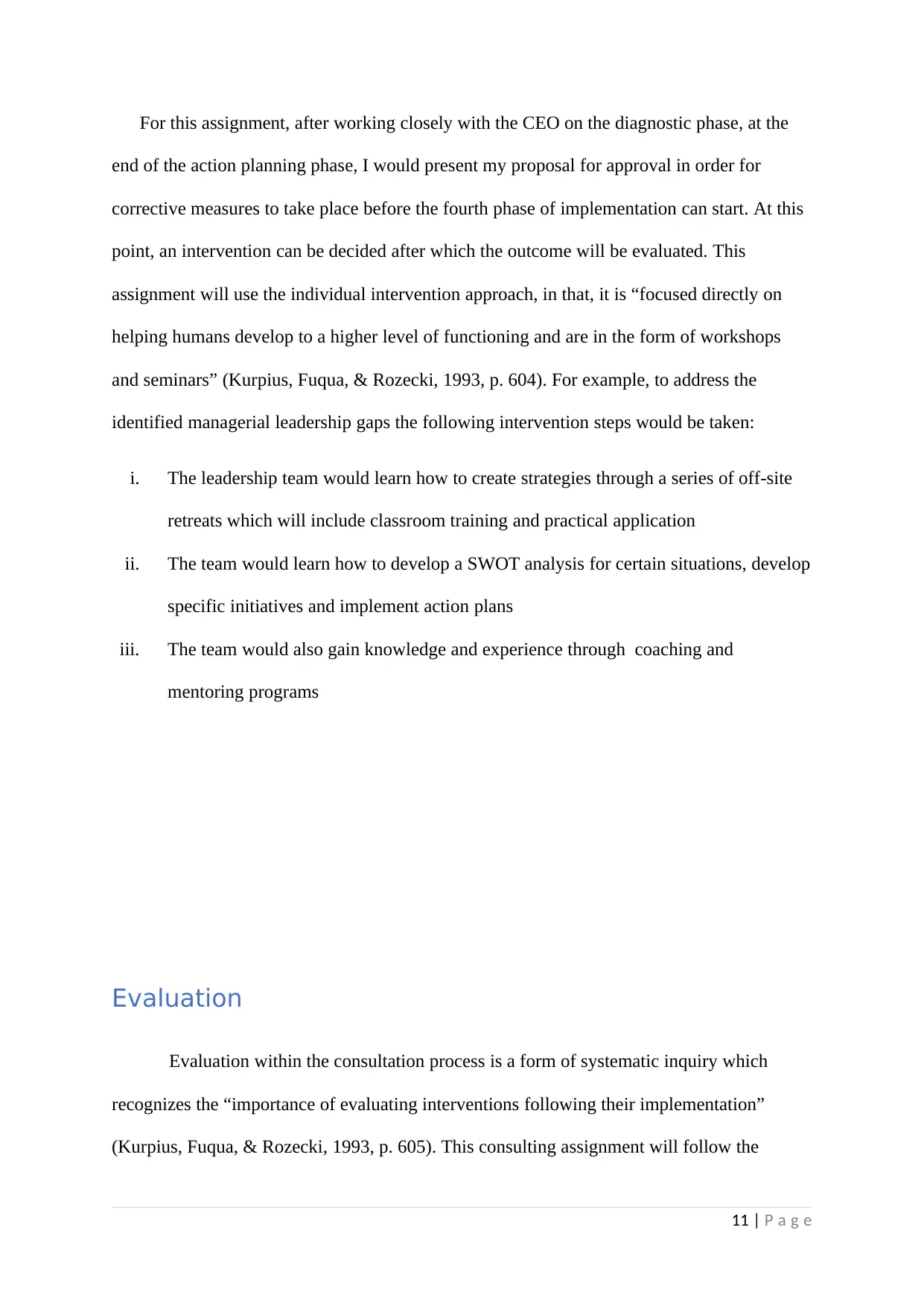
For this assignment, after working closely with the CEO on the diagnostic phase, at the
end of the action planning phase, I would present my proposal for approval in order for
corrective measures to take place before the fourth phase of implementation can start. At this
point, an intervention can be decided after which the outcome will be evaluated. This
assignment will use the individual intervention approach, in that, it is “focused directly on
helping humans develop to a higher level of functioning and are in the form of workshops
and seminars” (Kurpius, Fuqua, & Rozecki, 1993, p. 604). For example, to address the
identified managerial leadership gaps the following intervention steps would be taken:
i. The leadership team would learn how to create strategies through a series of off-site
retreats which will include classroom training and practical application
ii. The team would learn how to develop a SWOT analysis for certain situations, develop
specific initiatives and implement action plans
iii. The team would also gain knowledge and experience through coaching and
mentoring programs
Evaluation
Evaluation within the consultation process is a form of systematic inquiry which
recognizes the “importance of evaluating interventions following their implementation”
(Kurpius, Fuqua, & Rozecki, 1993, p. 605). This consulting assignment will follow the
11 | P a g e
end of the action planning phase, I would present my proposal for approval in order for
corrective measures to take place before the fourth phase of implementation can start. At this
point, an intervention can be decided after which the outcome will be evaluated. This
assignment will use the individual intervention approach, in that, it is “focused directly on
helping humans develop to a higher level of functioning and are in the form of workshops
and seminars” (Kurpius, Fuqua, & Rozecki, 1993, p. 604). For example, to address the
identified managerial leadership gaps the following intervention steps would be taken:
i. The leadership team would learn how to create strategies through a series of off-site
retreats which will include classroom training and practical application
ii. The team would learn how to develop a SWOT analysis for certain situations, develop
specific initiatives and implement action plans
iii. The team would also gain knowledge and experience through coaching and
mentoring programs
Evaluation
Evaluation within the consultation process is a form of systematic inquiry which
recognizes the “importance of evaluating interventions following their implementation”
(Kurpius, Fuqua, & Rozecki, 1993, p. 605). This consulting assignment will follow the
11 | P a g e
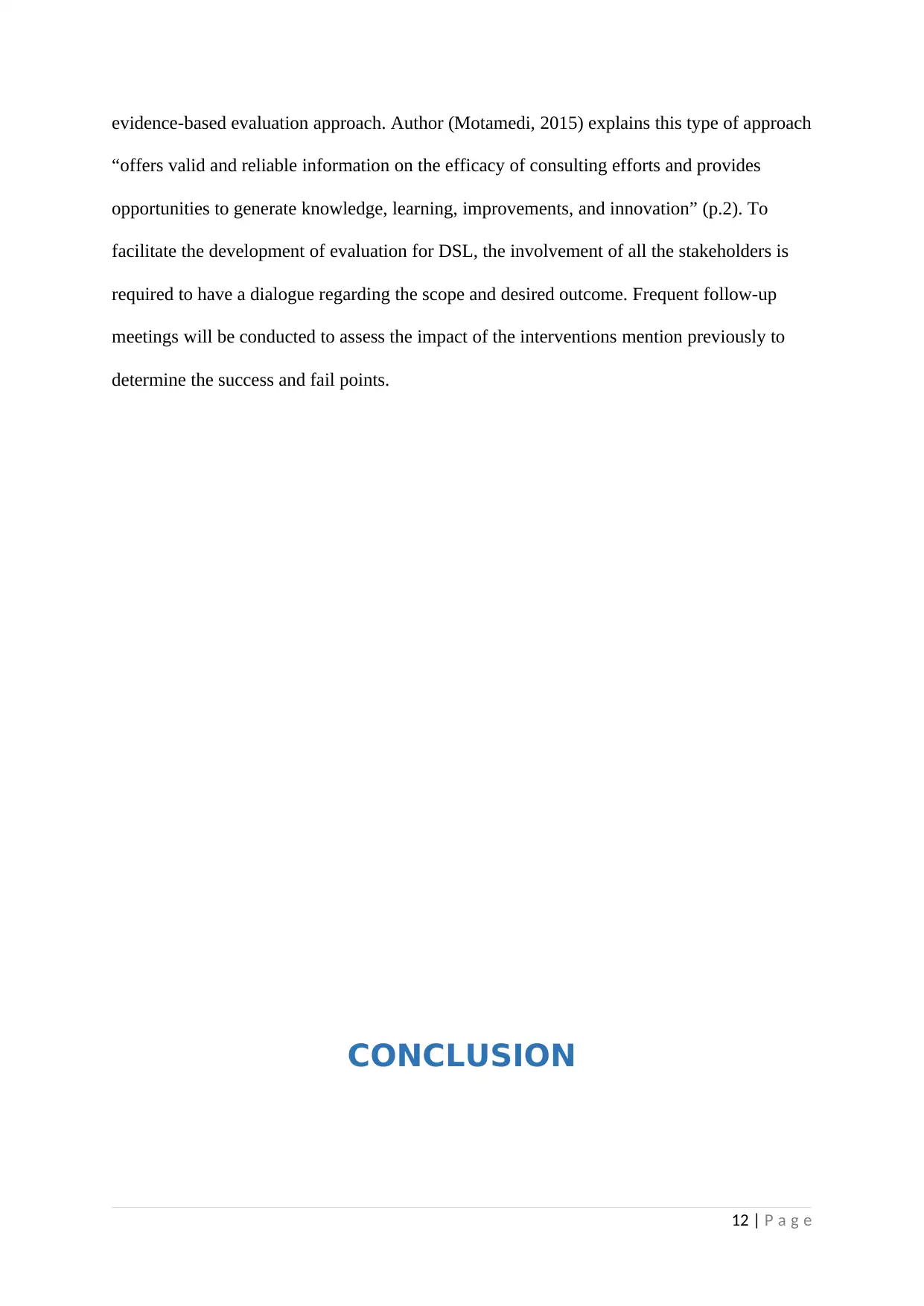
evidence-based evaluation approach. Author (Motamedi, 2015) explains this type of approach
“offers valid and reliable information on the efficacy of consulting efforts and provides
opportunities to generate knowledge, learning, improvements, and innovation” (p.2). To
facilitate the development of evaluation for DSL, the involvement of all the stakeholders is
required to have a dialogue regarding the scope and desired outcome. Frequent follow-up
meetings will be conducted to assess the impact of the interventions mention previously to
determine the success and fail points.
CONCLUSION
12 | P a g e
“offers valid and reliable information on the efficacy of consulting efforts and provides
opportunities to generate knowledge, learning, improvements, and innovation” (p.2). To
facilitate the development of evaluation for DSL, the involvement of all the stakeholders is
required to have a dialogue regarding the scope and desired outcome. Frequent follow-up
meetings will be conducted to assess the impact of the interventions mention previously to
determine the success and fail points.
CONCLUSION
12 | P a g e
Paraphrase This Document
Need a fresh take? Get an instant paraphrase of this document with our AI Paraphraser
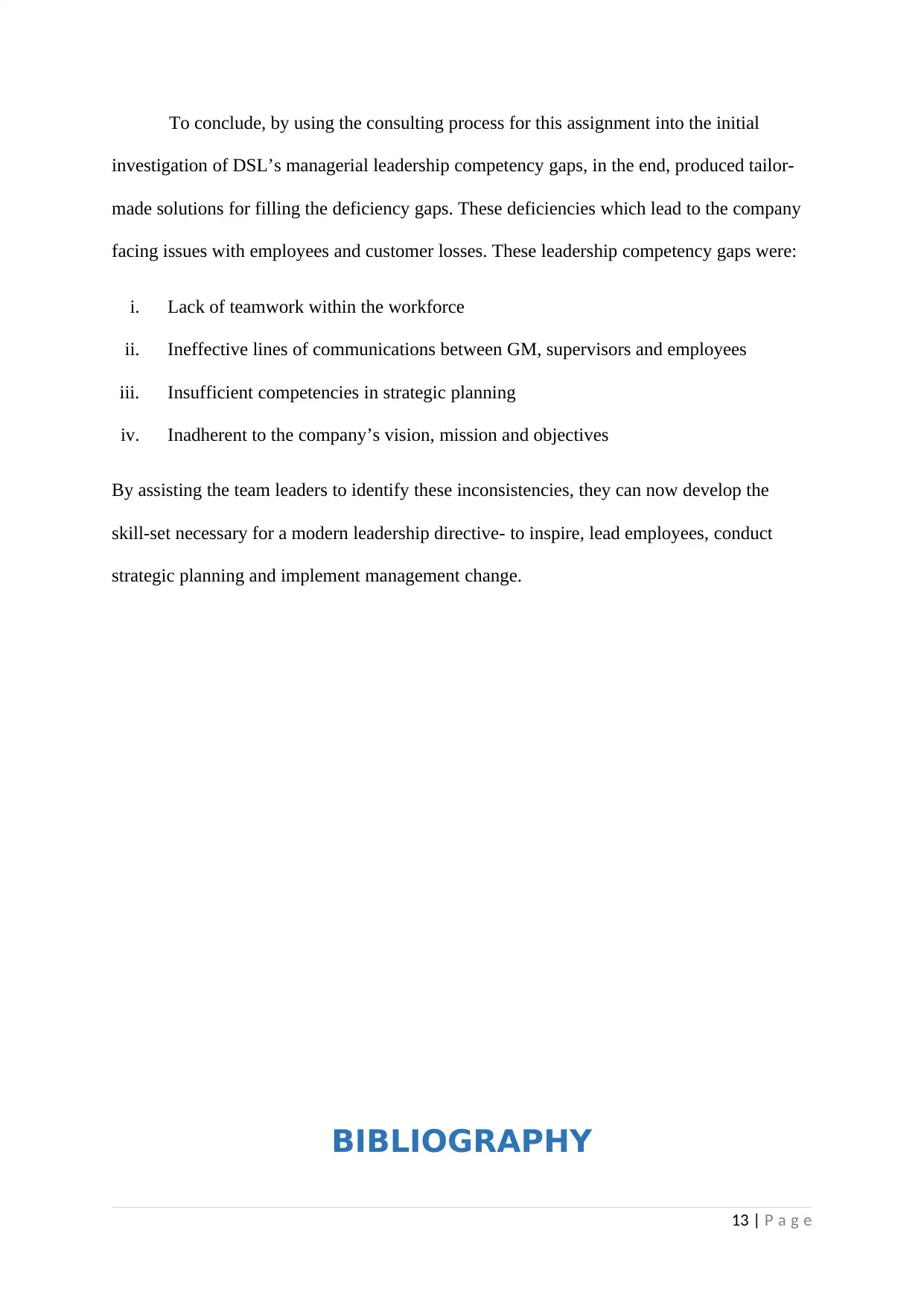
To conclude, by using the consulting process for this assignment into the initial
investigation of DSL’s managerial leadership competency gaps, in the end, produced tailor-
made solutions for filling the deficiency gaps. These deficiencies which lead to the company
facing issues with employees and customer losses. These leadership competency gaps were:
i. Lack of teamwork within the workforce
ii. Ineffective lines of communications between GM, supervisors and employees
iii. Insufficient competencies in strategic planning
iv. Inadherent to the company’s vision, mission and objectives
By assisting the team leaders to identify these inconsistencies, they can now develop the
skill-set necessary for a modern leadership directive- to inspire, lead employees, conduct
strategic planning and implement management change.
BIBLIOGRAPHY
13 | P a g e
investigation of DSL’s managerial leadership competency gaps, in the end, produced tailor-
made solutions for filling the deficiency gaps. These deficiencies which lead to the company
facing issues with employees and customer losses. These leadership competency gaps were:
i. Lack of teamwork within the workforce
ii. Ineffective lines of communications between GM, supervisors and employees
iii. Insufficient competencies in strategic planning
iv. Inadherent to the company’s vision, mission and objectives
By assisting the team leaders to identify these inconsistencies, they can now develop the
skill-set necessary for a modern leadership directive- to inspire, lead employees, conduct
strategic planning and implement management change.
BIBLIOGRAPHY
13 | P a g e
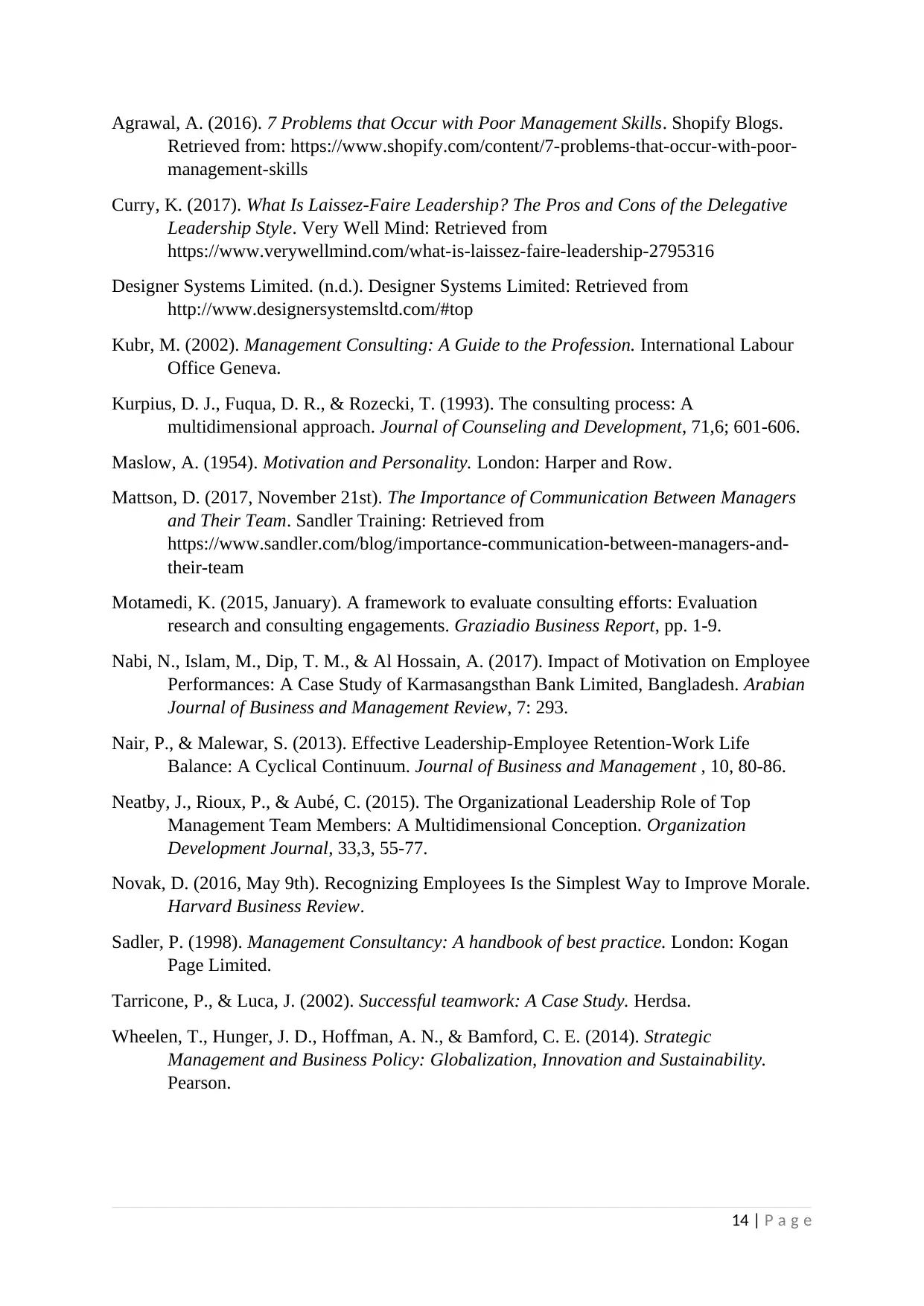
Agrawal, A. (2016). 7 Problems that Occur with Poor Management Skills. Shopify Blogs.
Retrieved from: https://www.shopify.com/content/7-problems-that-occur-with-poor-
management-skills
Curry, K. (2017). What Is Laissez-Faire Leadership? The Pros and Cons of the Delegative
Leadership Style. Very Well Mind: Retrieved from
https://www.verywellmind.com/what-is-laissez-faire-leadership-2795316
Designer Systems Limited. (n.d.). Designer Systems Limited: Retrieved from
http://www.designersystemsltd.com/#top
Kubr, M. (2002). Management Consulting: A Guide to the Profession. International Labour
Office Geneva.
Kurpius, D. J., Fuqua, D. R., & Rozecki, T. (1993). The consulting process: A
multidimensional approach. Journal of Counseling and Development, 71,6; 601-606.
Maslow, A. (1954). Motivation and Personality. London: Harper and Row.
Mattson, D. (2017, November 21st). The Importance of Communication Between Managers
and Their Team. Sandler Training: Retrieved from
https://www.sandler.com/blog/importance-communication-between-managers-and-
their-team
Motamedi, K. (2015, January). A framework to evaluate consulting efforts: Evaluation
research and consulting engagements. Graziadio Business Report, pp. 1-9.
Nabi, N., Islam, M., Dip, T. M., & Al Hossain, A. (2017). Impact of Motivation on Employee
Performances: A Case Study of Karmasangsthan Bank Limited, Bangladesh. Arabian
Journal of Business and Management Review, 7: 293.
Nair, P., & Malewar, S. (2013). Effective Leadership-Employee Retention-Work Life
Balance: A Cyclical Continuum. Journal of Business and Management , 10, 80-86.
Neatby, J., Rioux, P., & Aubé, C. (2015). The Organizational Leadership Role of Top
Management Team Members: A Multidimensional Conception. Organization
Development Journal, 33,3, 55-77.
Novak, D. (2016, May 9th). Recognizing Employees Is the Simplest Way to Improve Morale.
Harvard Business Review.
Sadler, P. (1998). Management Consultancy: A handbook of best practice. London: Kogan
Page Limited.
Tarricone, P., & Luca, J. (2002). Successful teamwork: A Case Study. Herdsa.
Wheelen, T., Hunger, J. D., Hoffman, A. N., & Bamford, C. E. (2014). Strategic
Management and Business Policy: Globalization, Innovation and Sustainability.
Pearson.
14 | P a g e
Retrieved from: https://www.shopify.com/content/7-problems-that-occur-with-poor-
management-skills
Curry, K. (2017). What Is Laissez-Faire Leadership? The Pros and Cons of the Delegative
Leadership Style. Very Well Mind: Retrieved from
https://www.verywellmind.com/what-is-laissez-faire-leadership-2795316
Designer Systems Limited. (n.d.). Designer Systems Limited: Retrieved from
http://www.designersystemsltd.com/#top
Kubr, M. (2002). Management Consulting: A Guide to the Profession. International Labour
Office Geneva.
Kurpius, D. J., Fuqua, D. R., & Rozecki, T. (1993). The consulting process: A
multidimensional approach. Journal of Counseling and Development, 71,6; 601-606.
Maslow, A. (1954). Motivation and Personality. London: Harper and Row.
Mattson, D. (2017, November 21st). The Importance of Communication Between Managers
and Their Team. Sandler Training: Retrieved from
https://www.sandler.com/blog/importance-communication-between-managers-and-
their-team
Motamedi, K. (2015, January). A framework to evaluate consulting efforts: Evaluation
research and consulting engagements. Graziadio Business Report, pp. 1-9.
Nabi, N., Islam, M., Dip, T. M., & Al Hossain, A. (2017). Impact of Motivation on Employee
Performances: A Case Study of Karmasangsthan Bank Limited, Bangladesh. Arabian
Journal of Business and Management Review, 7: 293.
Nair, P., & Malewar, S. (2013). Effective Leadership-Employee Retention-Work Life
Balance: A Cyclical Continuum. Journal of Business and Management , 10, 80-86.
Neatby, J., Rioux, P., & Aubé, C. (2015). The Organizational Leadership Role of Top
Management Team Members: A Multidimensional Conception. Organization
Development Journal, 33,3, 55-77.
Novak, D. (2016, May 9th). Recognizing Employees Is the Simplest Way to Improve Morale.
Harvard Business Review.
Sadler, P. (1998). Management Consultancy: A handbook of best practice. London: Kogan
Page Limited.
Tarricone, P., & Luca, J. (2002). Successful teamwork: A Case Study. Herdsa.
Wheelen, T., Hunger, J. D., Hoffman, A. N., & Bamford, C. E. (2014). Strategic
Management and Business Policy: Globalization, Innovation and Sustainability.
Pearson.
14 | P a g e
1 out of 15
Related Documents
Your All-in-One AI-Powered Toolkit for Academic Success.
+13062052269
info@desklib.com
Available 24*7 on WhatsApp / Email
![[object Object]](/_next/static/media/star-bottom.7253800d.svg)
Unlock your academic potential
© 2024 | Zucol Services PVT LTD | All rights reserved.





